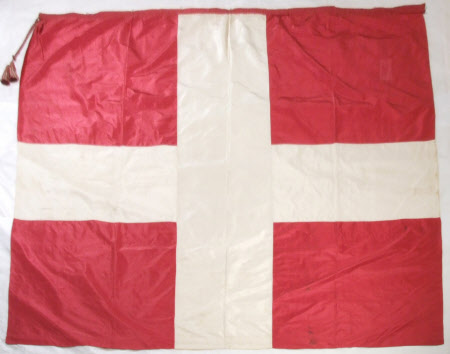Flag
Category
Textiles
Date
c. 1600 - c. 1700
Materials
Taffeta
Measurements
2150 x 2080 mm; 2020 mm (Height)
Order this imageCollection
Buckland Abbey, Devon
NT 809871
Caption
The Drake Colours are a set of 8 flags, sometimes known as the Drake Banners or Drake Standards. Six of these (809871, 809872, 809873, 809874, 809875 and 809876) flags are thought to be a set of Colours for a militia regiment of 6 companies. In the 16th and 17th centuries, County Militias, organised at the local level and commanded by county gentry, were England’s ‘home defence’. Each of Buckland’s six flags are made of crimson silk taffeta. 4 have white crosses, and 5 have distinctive gold symbols, each used to identify the officers of the six companies including a fleur-de-lys (809872), a bezant (roundel) (809873), a falcon (809874), an eight-pointed star (809875) and a streamer (pile wavy) (809876.) This form of decoration was often designed to show off the military rank of the officer with symbols or devices taken from the family crest. The star (809875) is taken from the Drake Coat of Arms granted to Sir Francis Drake in 1581. From 1697 until his death in 1718, Sir Francis Henry Drake (3rd Baronet, 1647-1718) had the rank of Colonel and was in command of a regiment that was part of the ‘Militia for the County of Devon’. His regiment was made up of 6 companies so it is possible that the flags relate to his command. Over the years, these six flags, and two 16th century Royal Standards (809869 and 809870) came to be known collectively as the ‘Drake Colours’ as all eight came to be associated with Sir Francis Drake. The flags were passed down through subsequent generations of the Drake family and were occasionally loaned to Buckland Abbey after it was opened to the public in 1951. They were displayed alongside other ‘Drake relics’ in the Great Hall. In 1954, they were acquired by the National Trust in lieu of tax. Today, two of the flags are always on display at Buckland Abbey in climate conditioned cases. Due to their fragility, the flags are displayed on rotation, changing every 2-3 years.
Summary
A 17th century,crimson silk taffeta flag decorated with a white cross. The flag has a linen lined hose (sleeve) to take a wooden staff. Red and white tasselled cords sewn to the top of the flag would have helped to tie the flag to the staff. Part of a set of 8 flags popularly known as 'The Drake Colours.'
Provenance
Accepted in Lieu of Tax, 1954
